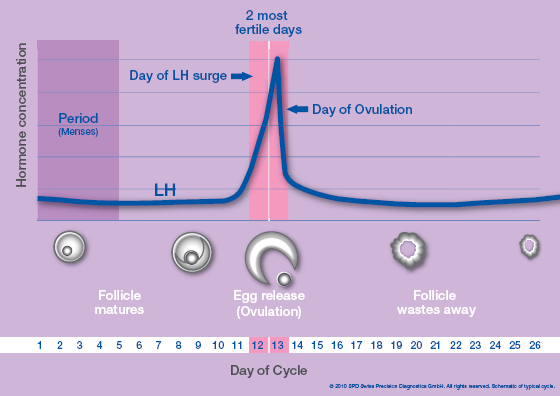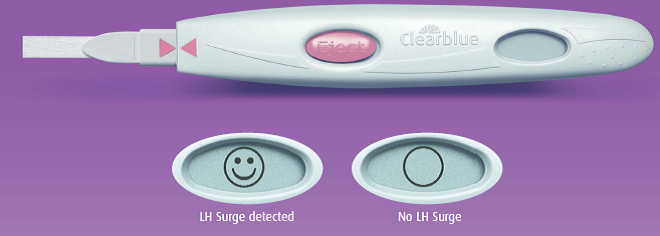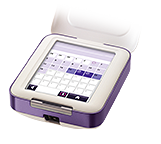Pinpoints her 2 most fertile days
Over 99% accurate in detecting the LH surge
The Clearblue Digital Ovulation Test range is over 99% accurate in detecting the urinary luteinising hormone (LH) surge that occurs 24–36 hours prior to ovulation.1

Typical menstrual cycle showing the developing follicle and the urinary surge in luteinising hormone.
To achieve these results, this home ovulation testing kit employs a rapid "sandwich" assay which incorporates two distinct antibodies to detect two separate antigenic sites on the LH molecule: the αLH site and βLH site.
If LH is present in the user's urine, its βLH antigen site is bound by the anti-βLH antibody immobilised on blue latex complex and the αLH antigenic site is bound by the anti-αLH antibodies, resulting in an intense blue "Surge Line" which is read by Clearblue's Digital Holder. If the Clearblue Digital Holder detects that the test was completed successfully and that the Surge Line intensity is over a certain threshold, the display will show a "LH Surge" result. This indicates that conception is most likely if intercourse occurs during the next 48 hours.
It is known that many women have small levels of LH present in their urine throughout their cycles. The Clearblue Digital Ovulation Test therefore sets a personalised threshold level for each woman, by measuring their change in LH level from their personal baseline.
Correctly interpreting whether or not there is an LH surge on a traditional line test can be difficult for users, with as many as one in four women misreading the result from a traditional home ovulation test.2 Digital results take away this potential human error and data shows that when compared to traditional line tests, the Clearblue Digital Ovulation Test is more accurately read by consumers.2
Variation exists with regard to total menstrual cycle duration between and among women, and such variation appears to result from changes in the early, follicular phase of the cycle.3 Because of these differences in follicular phase length, the day of the LH surge varies from woman to woman and from cycle to cycle, making it more challenging to accurately detect the timing of peak fertility. Typically, menstrual cycle length can range anywhere between 23 and 35 days, with 52% of cycles varying by five days or more.4 Studies have therefore shown that performing 20 tests rather than 7 or 5 offers a greater chance of testing on the correct day. Indeed using 20 tests per cycle covered 99% of LH surge days in women with typical cycles when using the Clearblue Digital Ovulation Test.2
In order to help women with regular or irregular cycles, Clearblue produces two digital ovulation packs:
- the Clearblue Digital Ovulation Test – 10 Test Pack, for women with regular cycles
- the Clearblue Digital Ovulation Test – 20 Test Pack that gives women a greater chance of detecting their LH surge and time of peak fertility, and is particularly suited for use by women with irregular cycles.2 In a study, the Clearblue Digital Ovulation Test – 20 Test Pack was able to detect over 99% of LH surges, in cycles 21-42 days long.2

The Clearblue Digital Ovulation Test range is:
- Accurate – over 99% accurate in detecting the LH surge in urine1 to pinpoint her 2 most fertile days
- Adaptive - adapts to a woman's own LH surge threshold
- Unmistakably clear – provides clear digital results for greater accuracy in consumers’ hands
- Simple to use - easy read digital results
- Trustworthy - from Clearblue, the world’s number one selling brand in home pregnancy and fertility tests.
- 1 SPD data on file. Clearblue Digital Ovulation Test has been shown to be over 99% accurate when compared to a reference method in laboratory studies using urine samples from 123 cycles where LH surge was identified by a reference method.
- 2 Johnson SR, Shaw R. Testing strategies for the home detection of the LH surge. SPD data on file.
- 3 Creinin MD, Keverline S, Meyn LA. How regular is regular? An analysis of menstrual cycle regularity. Contraception 2004 Oct;70(4):289-92.
- 4 I Soumpasis, B Grace, S Johnson. Real-life insights on menstrual cycles and ovulation using big data, Human Reproduction Open, Volume 2020, Issue 2, 2020, hoaa011.


